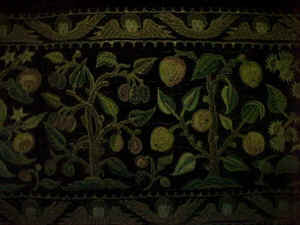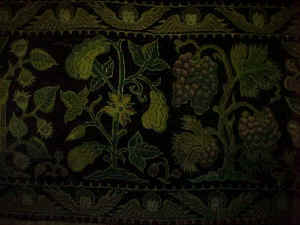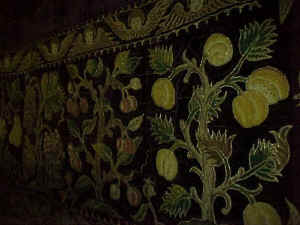The Culpeper Needlework
Under closed glass in the vestry of All Saint's Church at Hollingbourne will be found
an impressive 17th century needlework
generally associated with the Culpepers. The vestry is normally locked and closed to the
public, but a private showing can generally be arranged by placing an advance
call to the Vicar.
The Culpeper Needlework at Hollingbourne
|
 |
 |
|
Sectional photographs taken
March 2000 by Warren Culpepper |
Origin
According to Hasted, in 'The History and Topographical
Survey of the County of Kent', Volume V (1798):
'There is belonging to the church, a most superb altar-cloth,
and a pulpit-cloth and cushion, of purple velvet, ornamented with different
figures of fruits and pomegranates and grapes, wrought in gold, the needlework
of the daughters of Sir John Colepeper13, afterwards created Lord
Colepeper, who employed themselves for almost the space of twelve years in the
working of them, during their father's absence abroad with King Charles II.'
At the time Hasted wrote volume V of his 'History' his
son was Vicar of Hollingbourne and may have had some evidence, which has now
been lost. Sir John's second wife Judith was the daughter of Lady Elizabeth
and Sir Thomas of Greenway Court and had three daughters.
Since Hasted's time
the daughters who supposedly did the needlework have become the daughters of
Lady Elizabeth and they performed their work during the Commonwealth period by
which time their number was considerably reduced. With a piece of needlework
which consisted of cherubs and plant panels, most probably bought in London,
it seems unlikely that the ladies of the house would tack the needlework to
the velvet when they had skilled servants accustomed to such tasks.
Altar Cloth or Funeral Pall?
Was it an altar cloth? If so it was a very large one. In Charing Church there is preserved a communion table which is
probably the one mentioned in the Churchwardens' Accounts as having been made
in 1624 for 16 shillings. Less than six feet in length it would be lost under
the Hollingbourne needlework.
John Newman's 'North East and East Kent' suggests that it might be a
funeral pall because of its size. The authorities at the Victoria and Albert
Museum (who keep an eye on the condition of the needlework) have now accepted
this theory. It is instructive to note that a document recording Baldwin
Duppa's funeral at Hollingbourne Church in 1737 mentions 'covering the hearse
with velvet' and 'a Large Velvet Pall with a Sarssnett over the body'.
Fruit Plants Portrayed
 The plants portrayed on the needlework are reminiscent of
those depicted rather stiffly in the woodcuts of Gerard's late 16th century
Herbal. They have been described as
the Fruits of the Tree of Life mentioned
in 'Revelation' chapter 22, verses 1 and 2. If so, the description does not tally with the literal wording
of 'The New English Bible' which says that the Tree of Life 'Yields twelve
crops of fruit, one for each month of the year', not twelve different kinds of
fruits. The thirty fruits shown on the pall appear to be three pomegranates,
three plums or damsons, two cherries, three grapes (green and purple), three
gourds, three nuts (cob and hazel), two pears, three apples, crabs or quinces,
one hop, three mulberries, two oak acorns and two uncertain. The mulberry is
said to have been introduced into England in 1596. The Pomegranate was a badge
of the Tudors. The needlework is special in that it shows Jacobean fruits in
colors. Contemporary books only showed them in black and white woodcuts,
The plants portrayed on the needlework are reminiscent of
those depicted rather stiffly in the woodcuts of Gerard's late 16th century
Herbal. They have been described as
the Fruits of the Tree of Life mentioned
in 'Revelation' chapter 22, verses 1 and 2. If so, the description does not tally with the literal wording
of 'The New English Bible' which says that the Tree of Life 'Yields twelve
crops of fruit, one for each month of the year', not twelve different kinds of
fruits. The thirty fruits shown on the pall appear to be three pomegranates,
three plums or damsons, two cherries, three grapes (green and purple), three
gourds, three nuts (cob and hazel), two pears, three apples, crabs or quinces,
one hop, three mulberries, two oak acorns and two uncertain. The mulberry is
said to have been introduced into England in 1596. The Pomegranate was a badge
of the Tudors. The needlework is special in that it shows Jacobean fruits in
colors. Contemporary books only showed them in black and white woodcuts,
Embroidery Details
Although this needlework is reputed to have been made by the Culpeper ladies
in the mid 17th century, the design and the use of applied work on
velvet is typical of an earlier period and may have been influenced by the
revival of ecclesiastical embroidery under Archbishop Laud (1573-1645), who
re-introduced some of the richness into church decoration after a period of
austerity.
The purple velvet is of fine quality and possibly Italian, the
interlining of coarse, light blue linen, and the backing a later replacement.
The embroidery is worked in silk and either silver-gilt or gold thread. The
design is a deep triple border of cherubs enclosing plant slips with a narrow
border of metal thread, couched with cream silk, and small triangular areas in
red, green, blue, cream and brown at random.
There are two designs of cherubs arranged alternatively, all
worked in tent stitch, using silks, on fine linen and applied. From the very
large number of cherubs and the various standards of workmanship, it is
probable they were the work of many hands. During the seventeenth century,
trained draftsmen produced designs, which were printed on to linen and worked
by professional embroiderers who then sold them to customers. Similar cherubs
to these can be found on ecclesiastic work elsewhere, and it is possible that the Culpeper ladies may have
bought them already worked and just applied them. Between the cherubs small
stars have been worked directly on to the velvet, probably in smooth silver
purl but much of the metal has corroded leaving the silk core.
The plant slips are all of the finest workmanship and much
superior to the cherubs. They are sewn with great artistic skill either with
realistic shading or in interesting patterns such as checkered or stripes. All
are worked in tent stitch using silks except in two small places: the center
of one pomegranate flower and the eye of one pear have been embellished with
short lengths of metal thread, probably rough purl. The majority of the slips
are recognizable species, probably taken from illustrations in an herbal, but
there are a few flowers, not botanically correct, added to balance the design.
Because of the originality of the plant slips they were probably hand drawn on
to the linen, not printed.
Source: The above
text extracted from various church pamphlets.
Go to next page for Culpepers
at Hollingbourne